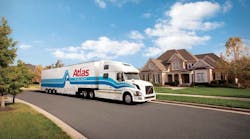Part and parcel of making safety an integral part of every work day at UPS is the company's Comprehensive Health & Safety Process (CHSP).
Launched in 1995, the program has helped UPS reduce lost workdays due to injuries by over 50%. If that weren't all, UPS says all other safety indices, including lost-time injuries, OSHA recordable and auto accident frequencies, have been “significantly reduced.”
The company says employee involvement and management support are the foundation of the program's remarkable success. CHSP, notes UPS, was modeled after its experience with OSHA's “Maine 200” program, which benchmarked best-in-class companies for their safety performance.
The program works through more than 240 CHSP committees at UPS facilities across the country. Each committee consists of non-management employees (both drivers and package handlers) supported by a local management co-chair. With a minimum of five persons on each committee, some 1,200 employees are involved in the effort.
Each committee conducts local facility and equipment audits; performs work practices and behavior analyses; conducts training, and recommends work process and equipment changes.
Perhaps greatly responsible for the program success is its local content and that, according to UPS, non-management employees “take the lead and drive the committee's activities. In other words, it's truly safety from the ground up.
Here are some of the ways the committees have made big impacts on the company' safety results, both locally and across the company:
-
A Willow Grove, PA, committee suggested design enhancements to the tractor-trailer dolly to make it easier and safer to maneuver.
-
The committee in the Desert Mountain District and the South California automotive group developed a device that counts how many times a UPS package car is put in reverse. The counters spurred a contest to see which driver could achieve the biggest reduction in backing maneuvers.
-
A Syracuse, NY committee designed a tool to check clearance on bench grinders.
-
At the Chicago Area Consolidation Hub, CHSP committees jointly launched the SWEEP (Safety While Evaluating, Educating and Preventing) program. SWEEP groups monitor the safety of their work areas, advise fellow employees of safe work methods, assist with ongoing safety training, and train newly hired workers.
-
Committees in the Iowa District established a number of safety best practices, including asking retirees to join the committees to bring in invaluable knowledge and experience.
-
System-wide, many of the improvements made to both package cars and road tractors have come from the suggestions of UPS drivers.
“The Comprehensive Health and Safety Process is making UPS a safer place to work by educating employees on how to identify workplace hazards, determine the root causes, recommend work process and equipment changes and develop comprehensive strategies to avoid injuries,” states corporate CHSP manager Dan Norman.
“UPS is making improvements because our people are taking ownership of their own workplace environment.”
If similar programs were instituted in other fleets, the size and scope might differ but the magnitude of the results should not. After all, nothing grows faster or stronger than what you plant and nurture yourself.


